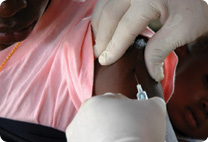High Physical Activity May Decrease Risk of Age-Related Cataract
High total physical activity, especially in the long term, may be associated with decreased risk of age-related cataract, according to a study in Ophthalmology.1
Jinjin Selin, MSc, of the Institute of Environmental Medicine, Karolinska Institutet, Sweden, and colleagues conducted a population-based prospective cohort study of 52,660 patients (23,853 women and 28,807 men; age, 45–83 years) from the Swedish Mammography Cohort and the Cohort of Swedish Men. The investigators assessed patients’ physical activity using a self-administered questionnaire at baseline. Cataract diagnosis and extraction were identified through linkage to registers.
During a mean 12.1 years of follow-up, 11,580 incident age-related cataract cases were identified. After adjusting for potential confounders, the highest quartile of total physical activity was statistically significantly associated with a 13% decreased risk of cataract compared with the lowest (HR, 0.87; 95% CI, 0.82–0.92). Walking or bicycling (>60 minutes per day vs hardly ever; HR, 0.88; 95% CI, 0.82–0.95) and work or occupational activity (heavy manual labor vs mostly sitting; HR, 0.84; 95% CI, 0.78–0.91) were also associated with decreased risk of cataract. Exercise training and housework were not associated with cataract risk.
Leisure time inactivity was associated with increased risk of cataract (>6 hours per day vs <1 hour per day; HR, 1.27; 95% CI, 1.07–1.50). The HR for high long-term physical activity compared with low levels both at 30 years of age and at baseline was 0.76 (95% CI, 0.69–0.85).
“Our results indicate that high levels of total and specific types of physical activity, including walking or bicycling and work or occupational activity, may be associated with decreased risk of age-related cataract,” the study authors wrote. “This inverse association seemed to be even stronger among those with long-term consistently high levels of total physical activity. Our results are in accordance with the inverse association between physical activity and risk of cardiovascular disease, type 2 diabetes, and other chronic diseases and further add to a long list of health benefits of physical activity.”
1. Selin JZ, Orsini N, Lindblad BE, Wolk A. Long-term physical activity and risk of age-related cataract. Ophthalmology. 2015;122(2):274-280.
Small Myopic Shift Observed 1 Year After Wavefront-Guided Myopic LASIK
In a study published in the Journal of Refractive Surgery,1 a small myopic shift and an increase in higher-order aberrations (HOAs) were observed when wavefront aberrometry results were compared at postoperative day 1 with those at postoperative 1 year.
Charles Q. Yu, MD, and Edward E. Manche, MD, of the Byers Eye Institute at Stanford, Stanford University School of Medicine, conducted a study of 105 eyes of 105 patients who underwent wavefront-guided LASIK. Objective wavefront aberrometric refractions were recorded preoperatively, on postoperative day 1, and at postoperative year 1. Subjective manifest refractions were also collected at postoperative year 1.
The investigators found that, when comparing objective wavefront aberrometric refractions at 1 year postoperative with those at postoperative day 1, there was a mean 0.33 D spherical equivalent (SE) myopic shift. There was no significant difference in the number of eyes within 1.00 D of emmetropia SE measured by wavefront aberrometric refraction at postoperative day 1 or year 1. There was a correlation of R2=0.14 between the degree of preoperative myopia and myopic shift. Overall, HOAs were not increased at day 1 but increased significantly by year 1. Objective aberrometric refractions at postoperative day 1 can be useful in the predition of long-term refractive outcomes, the study authors concluded.
1. Yu CQ, Manche EE. Day 1 wavefront aberrometry for prediction of refractive outcomes at year 1 in myopic LASIK. J Refract Surg. 2015;31(3):170-174.
Stem Cells From Wisdom Teeth Can be Transformed Into Corneal Cells
Stem cells from the dental pulp of wisdom teeth can be turned into corneal cells and might one day be used to repair corneal scarring due to infection or injury, according to researchers at the University of Pittsburgh School of Medicine. The findings, published in Stem Cells Translational Medicine,1 indicated those cells could also become a new source of corneal transplant tissue made from patients’ own cells.
“Shortages of donor corneas and rejection of donor tissue do occur, which can result in permanent vision loss,” senior investigator James Funderburgh, PhD, a Professor of Ophthalmology at the University of Pittsburgh and Associate Director of the Louis J. Fox Center for Vision Restoration of University of Pittsburgh School of Medicine and the University of Pittsburgh, said in the news release. “Our work is promising because using the patient’s own cells for treatment could help us avoid these problems.”
Experiments conducted by first author Fatima Syed-Picard, PhD, also of the University of Pittsburgh Department of Ophthalmology, and coworkers showed that stem cells of the dental pulp, obtained from routine human third molar (wisdom tooth) extractions, could be turned into corneal stromal cells or keratocytes, which have the same embryonic origin.
The team injected the engineered keratocytes into the corneas of healthy mice, where they integrated without signs of rejection. They also used the cells to develop constructs of corneal stroma akin to natural tissue.
“Other research has shown that dental pulp stem cells can be used to make neural, bone, and other cells,” Dr. Syed-Picard said. “They have great potential for use in regenerative therapies.”
The researchers will assess whether the technique can correct corneal scarring in an animal model.
1. Syed-Picard FN, Du Y, Lathrop KL, et al. Dental pulp stem cells: a new cellular resource for corneal stromal regeneration [published online ahead of print February 20, 2015]. Stem Cells Transl Med. doi:10.5966/sctm.2014-0115.
IOP Sensor Implanted During Keratoprosthesis Procedure in Europe
Implandata Ophthalmic Products successfully implanted the first EyeMate IOP sensor in a European patient undergoing keratoprosthesis surgery, according to a company news release. The procedure was performed by Thomas Neuhann, MD, principal investigator of the sponsor-initiated ARGOS-KP01 trial. The telemetrically powered EyeMate IOP sensor noninvasively measures, monitors, and controls IOP in keratoprosthesis patients.
“Elevated IOP is a main issue with keratoprosthesis patients,” Dr. Neuhann said in the news release. “Approximately two-thirds of these patients already have glaucoma preoperatively, and management of secondary glaucoma remains a major challenge postoperatively.”
As a result, these patients frequently experience visual field loss and eventually go blind because of undetected and/or insufficiently controlled glaucoma, Dr. Neuhann explained.
“Right after implantation of the microsensor implant, the patient’s IOP can be measured at any chosen frequency, either continuously or on demand at a specific time,” Dr. Neuhann said. “Patients can perform measurements by themselves and under the conditions of everyday life.”
In the ongoing ARGOS-KP01 premarket study, Implandata intends to generate clinical data for the CE conformity process for use of the EyeMate in keratoprosthesis patients. Currently, the implant does not have the CE Mark or FDA approval.
In a parallel study, ARGOS-02, the company is testing the use of the sensor in patients with primary open-angle glaucoma who are undergoing cataract surgery. The company said it plans to conduct additional clinical studies in Europe and North America for broader applications for glaucoma treatment.
Actavis Completes US$70.5 Billion Acquisition of Allergan
Actavis has completed the acquisition of Allergan in a cash and equity transaction valued at approximately US$70.5 billion. The combination creates one of the world’s top 10 pharmaceutical companies by sales revenue, with annual pro forma revenues of more than US$23 billion anticipated in 2015.
Actavis expects the transaction to generate double-digit accretion to non-generally accepted accounting principles (GAAP) earnings within the first 12 months, including approximately US$1.8 billion in operating and financial synergies to be realized within 1 year following the close. These synergies exclude any additional revenue or manufacturing synergies, and are in addition to the US$475 million of annual savings previously announced by Allergan in connection with Project Endurance. Actavis further expects to generate strong operating cash flow in excess of US$8 billion in 2016, which would enable the company to rapidly de-lever the balance sheet.
An Actavis news release said the combination enhances the company’s international commercial opportunities. The company has an expanded commercial presence now including approximately 100 countries, with an enhanced presence across Canada, Europe, Southeast Asia, and Latin America and a strong footprint in China and India, the news release said.
The combined company will reportedly provide a strong commitment to research and development, with a level of investment of approximately US$1.7 billion expected in 2015, focused on the strategic development of innovative and durable value-enhancing products within brands, generics, biologics, and OTC portfolios, according to the news release. The company has more than 20 products in near- or mid-term development, including Cariprazine, Eluxadoline, Esmya, Aczone X, and Darpin AMD.
NightstaRx Receives US, European Orphan Drug Designation for Gene Therapy for Choroideremia
NightstaRx received FDA and European Medicines Agency orphan drug designation for its lead program, a gene therapy to treat choroideremia, an X-linked recessive disorder that leads to progressive blindness, according to a news release.
The therapy, developed by Robert MacLaren, MB ChB, DPhil, FRCOphth, FRCS, of Oxford’s Nuffield Laboratory of Ophthalmology, involves injecting a small modified virus, AAV2.REP1, to deliver the correct version of the choroideremia gene to cells in the retina. In a multicenter clinical trial, MacLaren et al found that, 6 months after treatment, six patients had subjective improvement in vision in dim light and two were able to read more lines on the eye chart.1
1. MacLaren RE, Groppe M, Barnard AR, et al. Retinal gene therapy in patients with choroideremia: initial findings from a phase 1/2 clinical trial. Lancet. 2014;383(9923):1129-1137.
Novartis and Alcon Sponsor Award Providing Grant Funding for Nonprofits in Ophthalmology
Novartis is calling for submissions for the 2015 eXcellence in Ophthalmology Vision Award (XOVA), which provides grants to support innovative, sustainable, not-for-profit eye care projects worldwide that typically address the vision needs of underserved populations, according to a news release.
Launched in 2010 and cosponsored by the Pharmaceuticals and Alcon divisions of Novartis, XOVA has awarded more than €650,000 for 21 grants in 16 countries. XOVA will accept entries through April 30 from all eye care specialists including trainees and specialist nurses, with the support of their responsible institutions. Applications can be submitted via the XOVA program website: http://www.xovaprogram.org/index.html#apply.
“Preserving or restoring patients’ vision is vital, life-changing work, and the XOVA award aims to support projects that will achieve these outcomes in underserved populations,” Dirk Sauer, Global Head Development, Ophthalmology Franchise, Novartis Pharmaceuticals, said in the news release. “Past XOVA winners include programs that benefited patients by supporting education of health care professionals and patients or those that provided high-quality screening, treatment, and prevention, particularly in the long term.”
CLICKWORTHY
MEDICAL NEWS FOR THE MINDFUL OPHTHALMOLOGIST
Measles Fear for Ebola-Hit Countries

West African countries affected by Ebola are ripe for a measles outbreak that could infect thousands of hundreds of people, researchers warn.
http://www.bbc.com/news/health-31856278
Folic Acid Supplements Cut Stroke Risk in Patients With Hypertension

Hypertensive patients taking folic acid had a significantly decreased risk of first stroke.
http://www.medpagetoday.com/MeetingCoverage/ACC/50566
New Diet Linked to Reduced Risk of Alzheimer Disease

The so-called MIND eating plan is reportedly easier to follow than the Mediterranean and DASH diets and reduced Alzheimer risk by 35%.
http://www.medicalnewstoday.com/articles/291073.php
Power Naps May be Memory Booster

A 45-minute power nap may help to consolidate memories.
http://www.nhs.uk/news/2015/03March/Pages/Are-power-naps-a-five-fold-memory-booster.aspx
Exercise, Not Vitamin D, Cuts Injuries From Falls in Older Women

The risk of serious injury as a result of falling was cut by more than half when elderly women engaged in regular exercise.
http://consumer.healthday.com/bone-and-joint-information-4/bone-joint-and-tendon-news-72/exercise-but-not-vitamin-d-cuts-serious-falls-in-older-women-study-697651.html
